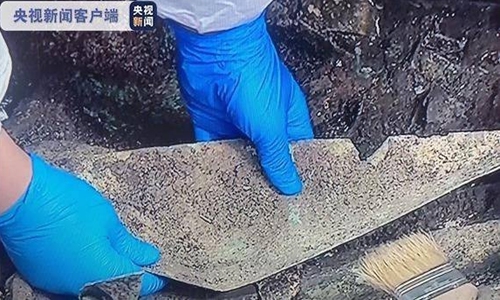
The unearthed eye-shaped bronze figurine Photo: CCTV
A civilization from millennia ago is waking up in Southwest China's Sichuan Province. Chinese archaeologists have excavated a number of 3,000-year-old relics at the Sanxingdui Ruins site, including an eye-shaped bronze work, a bronze figurine in a sleeping position and a bronze fragment containing the largest silk remains in eight major sacrificial pits on Sunday, reported China's Central Television (CCTV).
Tang Fei, dean of the Sichuan Provincial Cultural Relics and Archeology Research Institute, told the Global Times on Monday that this was not the first time that the archaeologists have found eye-shaped relics. They excavated more than 50 similar relics in the first and second pits, some of which are shaped like a rhombus while others are triangular formation.
A new excavated
relic in the third pit is triangle-shaped with an outer bulging eyeball in the center, and its corresponding half is stacked underneath it. It is 53 centimeters long and 15 centimeters wide.
"The large number of unearthed eye-shaped objects proves that the image of the eye had a special meaning in the spiritual world of the ancient Shu Kingdom, but the specific purpose of this image is unknown," said Tang. The Shu Kingdom dated back at least 4,800 years and lasted for more than 2,000 years.
Besides, a bronze figurine in a sleeping position was found in the fourth pit, whose head is connected with a broken grooved copper strip, the CCTV report said. ,The figurine's head is turned to the right side of the body, and it has a high nose and deep eye sockets. The artifact is 28 centimeters high. Two other relics of similar posture and size were previously discovered, and the three together may be components of a large, combined bronze ware.
About 60 gold tree leaves or fish-shaped relics have been excavated from the eighth pit of the ruins. Chinese archaeologists noted they were the decorations that had been hung in the bronze tree discovered there.
The silk remains of a bronze fragment unearthed in the eighth pit are currently the largest area of silk residue found in the Sanxingdui Ruins. "The newest research achievement for the Sanxingdui Ruins site is that we have confirmed that the silk relics were used in sacrificial offerings in the ancient dynasty," Tang said.
The Sanxingdui Ruins site was discovered in the late 1920s. It is the largest and highest-ranking centralized site ever found in the Sichuan Basin, and is believed to date back to the Xia (c.2,070 BC-c.1,600 BC) and Shang (c.1,600 BC-1,046 BC) dynasties




